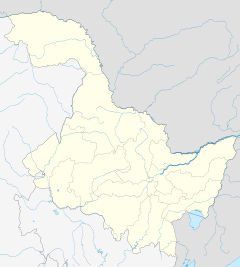Shuangyashan 双鸭山市 | |
|---|---|
 New Year's Parade in February 2002 | |
 Location of Shuangyashan City (yellow) in Heilongjiang (light grey) and China | |
| Coordinates(Shuangyashan municipal government): 46°40′34″N131°08′30″E / 46.6762°N 131.1416°E | |
| Country | People's Republic of China |
| Province | Heilongjiang |
| County-level divisions | 8 |
| Municipal seat | Jianshan District |
| Government | |
| • Type | Prefecture-level city |
| • CPC Shuangyashan Secretary | Li Xiangang (李显刚) |
| • Mayor | Wu Fengcheng (武凤呈) |
| Area | |
| • Prefecture-level city | 26,483 km2 (10,225 sq mi) |
| Population (2010) [1] | |
| • Prefecture-level city | 1,462,626 |
| • Urban | 507,257 |
| GDP | |
| • Prefecture-level city | CN¥ 43.3 billion US$ 7.0 billion |
| • Per capita | CN¥ 29,235 US$ 4,694 |
| Time zone | UTC+8 (China Standard) |
| Postal code | 155000 |
| Area code | 0469 |
| ISO 3166 code | CN-HL-05 |
| Licence plates | 黑J |
| Climate | Dwb |
- ↑ 2010年黑龙江省第六次全国人口普查主要数据公报. Heilongjiang Bureau of Statistics (黑龙江省统计局). Archived from the original on 15 August 2013. Retrieved 11 May 2011.
- ↑ 双鸭山城市介绍. jiaodong.net. 2008-09-15.
- ↑ 中国气象数据网 – WeatherBk Data (in Simplified Chinese). China Meteorological Administration . Retrieved 5 July 2023.
- ↑ 中国气象数据网 (in Simplified Chinese). China Meteorological Administration . Retrieved 5 July 2023.
- ↑ 2010年双鸭山市国民经济和社会发展统计公报. Heilongjiang Bureau of Statistics.
- ↑ Profiles of China Provinces, Cities and Industrial Parks
- ↑ Zhou, Pinglang (2016-04-28). "Children of Coal: Life After the Collapse". Sixth Tone. Archived from the original on 2021-12-01. Retrieved 2023-01-10.
External links
| Shuangyashan | |
|---|---|
 "Shuangyashan", as written in Chinese | |
| Romanization | Juru'niyehe'alin hoton |
Heilongjiang topics | |
|---|---|
| General | |
| Geography | |
| Education | |
| Visitor attractions | |
